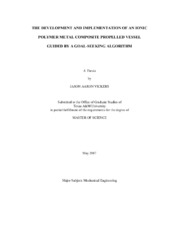| dc.description.abstract | This thesis describes the use of an ultrasonic goal-seeking algorithm while using ionic polymer metal composite (IPMC), an electroactive polymer, as the actuator to drive a vessel towards a goal. The signal transmitting and receiving circuits as well as the goal seeking algorithm are described in detail. Two test vessels were created; one was a larger vessel that contained all necessary components for autonomy. The second was a smaller vessel that contained only the sensors and IPMC strips, and all power and signals were transmitted via an umbilical cord. To increase the propulsive efforts of the second, smaller vessel, fins were added to the IPMC strips, increasing the surface area over 700%, determined to yield a 22-fold force increase. After extensive testing, it was found that the three IPMC strips, used as oscillating fins, could not generate enough propulsion to move either vessel, with or without fins. With the addition of fins, the oscillating frequency was reduced from 0.86-Hz to 0.25-Hz. However, the goal-seeking algorithm was successful in guiding the vessel towards the target, an ultrasonic transmitter. When moved manually according to the instructions given by the algorithm, the vessel successfully reached the goal. Using assumptions based on prior experiments regarding the speed of an IPMC propelled vessel, the trial in which the goal was to the left of the axis required 18.2% more time to arrive at the goal than the trial in which the goal was to the right. This significant difference is due to the goal-seeking algorithm’s means to acquire the strongest signal. After the research had concluded and the propulsors failed to yield desired results, many factors were considered to rationalize the observations. The operating frequency was reduced, and it was found that, by the impulse-momentum theorem, that the propulsive force was reduced proportionally. The literature surveyed addressed undulatory motion, which produces constant propulsive force, not oscillatory, which yields intermittent propulsive force. These reasons among others were produced to rationalize the results and prove the cause of negative results was inherent to the actuators themselves. All rational options have been considered to yield positive results. | en |


